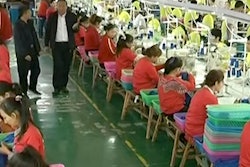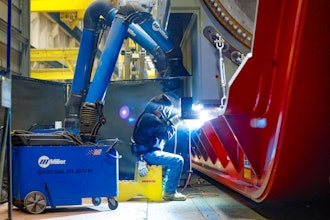Design and manufacturing expectations keep escalating. There's a heightened consumer desire for variety, customization, automation and technological innovation. Manufacturers across all industries want parts that are more durable, lighter weight, and cost-efficient. Deadlines are being compressed from months to weeks or even days.
Fortunately, 3D printing is addressing these challenges by shortening the prototyping process, stimulating new design innovation, and giving designers and manufacturers the ability to experiment with new product development processes before committing the big production bucks. And, all of it can be done via outsourcing.
3D printing outsourcing takes on many forms and is referred to by different names. It can encompass everything from rapid and functional prototyping to appearance models to low-volume production using both additive manufacturing and traditional subtractive processes.
Broad Range of Options
Even if a company has 3D printers in house, outsourcing selected work can open up options for printing using different materials, processes, properties and colors. These options can be used singularly, in combinations, and/or integrated with traditional processes.
The most commonly used systems for rapid prototyping are based on stereolithography (SLA). Although SLA has been around for more than 30 years, it hasn't stood still. The technology for creating precise and accurate resin-based parts has made huge leaps over the last three decades in areas such as speed, affordability, range of materials, cleanliness, level of detail, texturing, finishing, and overall automation of the 3D printing process. A company might have SLA systems in house, but they might pale in comparison to the latest and greatest at an outside facility.
Selective laser sintering (SLS) has been around about as long as SLA technology, but it too has continued to evolve rapidly in its ability to produce durable and heat-resistant parts. SLS doesn't require support structures, making it capable of producing geometries that no other technology can. Common SLS applications include housings, machinery components, functionality testing, jigs and fixtures, ducting, customized consumer goods, mechanical joints, snap fits, and living hinges.
MultiJet technology is an inkjet printing process that deposits either photo-curable plastic resin or casting wax layer by layer to build a part. MultiJet printers output parts with high accuracy and resolution. They are used for applications such as design validation, aesthetic assessment, performance and assembly testing, manufacturability testing, rapid tooling, and jigs and fixtures manufacturing.
ColorJet printing outputs full-color parts with complex geometries at high speeds. The realistic color range makes this technology appropriate for aesthetic and ergonomic evaluation of new designs and authentic-looking demonstration models for trade shows and sales presentations.
Direct metal printing (DMP) delivers high accuracy, precision and design freedom for handling complex free-form surfaces, lattice structures, conformal channels, and thin walls. DMP is used for end-use replacement parts, producing lighter-weight parts, reducing the number of parts within an assembly, increasing part performance, and strengthening parts and assemblies.
Fused deposition modeling (FDM) is commonly used for high-strength ABS-like parts and prototypes. It allows parts to go directly from 3D CAD to thermoplastic materials without tooling. Applications include design validation, fit and function testing, small production runs, and end-use jigs and fixtures.
The cast urethane process enables production of parts that mimic the appearance and physical properties of injection-molded parts. A 3D-printed master pattern is imprinted into SRM (silicone rubber mold) tooling, enabling manufacturers to deliver cast urethane parts within days. An additional benefit of the process is the ability to over-mold existing parts or hardware with a second material.
What to Look for in a Provider
Besides solid references and the experience one always seeks in an outsourced service provider, there are several key factors one should look for in a 3D printing partner, including:
- Ease of engagement — Free online quotes, fast turnaround and shipping times.
- Level of expertise — Proven success in all key areas of design, manufacturing and technologies related to the project.
- International footprint with localized service — Localized service to accommodate different cultures, languages and working conditions and a worldwide presence to ensure the greatest number of available resources and expertise.
- Diversity of approaches and capabilities -— Having the machines, expertise, materials and resources to meet a client's exact needs.
- Creative solutions — The ability to explore a solution that the customer might not have considered, but that delivers a breakthrough in design, performance and/or affordability.
Anticipating the Future
According to a report by the research firm Markets and Markets, the 3D printing market is expected to be worth $32.78 billion by 2023, with a compound annual growth rate (CAGR) of nearly 26 percent between now and 2023.
The report attributes this growth to factors such as the ease of development of customized products, ability to reduce overall manufacturing costs, and government investments in 3D printing projects for the development and deployment of the technology.
Additional factors specific to outsourced 3D printing include:
- Worldwide competitive pressures for faster time to market.
- The need for greater innovation to develop new products aligned to lifestyle and societal changes.
- Cost savings through the ability to verify design changes early in product development.
- The ability to implement just-in-time prototyping and low-volume manufacturing that speeds production and reduces warehousing and shipping costs.
- Increasing movement towards production agility and nimbleness vs. traditionally large, slow-moving operations.
All the indicators point to a bright future for those adopting 3D printing, either in-house, through outsourcing partnerships, or as a combination of both.
Ziad Abou is vice president and general manager of the 3D Systems On Demand division.





















